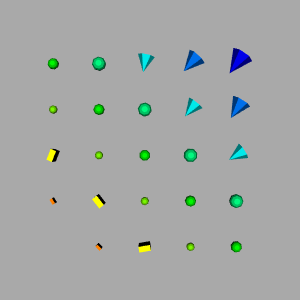GlyphTable
Repository source: GlyphTable
Question
If you have a question about this example, please use the VTK Discourse Forum
Code¶
GlyphTable.py
#!/usr/bin/env python
# noinspection PyUnresolvedReferences
import vtkmodules.vtkInteractionStyle
# noinspection PyUnresolvedReferences
import vtkmodules.vtkRenderingOpenGL2
from vtkmodules.vtkCommonColor import vtkNamedColors
from vtkmodules.vtkFiltersCore import (
vtkElevationFilter,
vtkGlyph3D
)
from vtkmodules.vtkFiltersSources import (
vtkConeSource,
vtkCubeSource,
vtkSphereSource
)
from vtkmodules.vtkImagingCore import vtkRTAnalyticSource
from vtkmodules.vtkImagingGeneral import vtkImageGradient
from vtkmodules.vtkInteractionStyle import vtkInteractorStyleTrackballCamera
from vtkmodules.vtkRenderingCore import (
vtkActor,
vtkPolyDataMapper,
vtkRenderWindow,
vtkRenderWindowInteractor,
vtkRenderer
)
# This example uses a "glyph table" to change the shape of the 3d glyphs
# according to a scalar value.
# NOTE: The vtkGlyph3D filter doesn't copy over scalars to the glyphs
# generated by a table like this for some reason...
def main():
colors = vtkNamedColors()
# The Wavelet Source is nice for generating a test vtkImageData set
rt = vtkRTAnalyticSource()
rt.SetWholeExtent(-2, 2, -2, 2, 0, 0)
# Take the gradient of the only scalar 'RTData' to get a vector attribute
grad = vtkImageGradient()
grad.SetDimensionality(3)
grad.SetInputConnection(rt.GetOutputPort())
# Elevation just to generate another scalar attribute that varies nicely over the data range
elev = vtkElevationFilter()
# Elevation values will range from 0 to 1 between the Low and High Points
elev.SetLowPoint(-2, -2, 0)
elev.SetHighPoint(2, 2, 0)
elev.SetInputConnection(grad.GetOutputPort())
# Create simple PolyData for glyph table
cs = vtkCubeSource()
cs.SetXLength(0.5)
cs.SetYLength(1)
cs.SetZLength(2)
ss = vtkSphereSource()
ss.SetRadius(0.25)
cs2 = vtkConeSource()
cs2.SetRadius(0.25)
cs2.SetHeight(0.5)
# Set up the glyph filter
glyph = vtkGlyph3D()
glyph.SetInputConnection(elev.GetOutputPort())
# Here is where we build the glyph table
# that will be indexed into according to the IndexMode
glyph.SetSourceConnection(0, cs.GetOutputPort())
glyph.SetSourceConnection(1, ss.GetOutputPort())
glyph.SetSourceConnection(2, cs2.GetOutputPort())
glyph.ScalingOn()
glyph.SetScaleModeToScaleByScalar()
glyph.SetVectorModeToUseVector()
glyph.OrientOn()
glyph.SetScaleFactor(1) # Overall scaling factor
glyph.SetRange(0, 1) # Default is (0,1)
# Tell it to index into the glyph table according to scalars
glyph.SetIndexModeToScalar()
# Tell glyph which attribute arrays to use for what
glyph.SetInputArrayToProcess(0, 0, 0, 0, 'Elevation') # scalars
glyph.SetInputArrayToProcess(1, 0, 0, 0, 'RTDataGradient') # vectors
coloring_by = 'Elevation'
mapper = vtkPolyDataMapper()
mapper.SetInputConnection(glyph.GetOutputPort())
mapper.SetScalarModeToUsePointFieldData()
mapper.SetColorModeToMapScalars()
mapper.ScalarVisibilityOn()
# GetRange() call doesn't work because attributes weren't copied to glyphs
# as they should have been...
# mapper.SetScalarRange(glyph.GetOutputDataObject(0).GetPointData().GetArray(coloring_by).GetRange())
mapper.SelectColorArray(coloring_by)
actor = vtkActor()
actor.SetMapper(mapper)
ren = vtkRenderer()
ren.AddActor(actor)
ren.SetBackground(colors.GetColor3d("DarkGray"))
renWin = vtkRenderWindow()
renWin.AddRenderer(ren)
renWin.SetWindowName('GlyphTable')
iren = vtkRenderWindowInteractor()
istyle = vtkInteractorStyleTrackballCamera()
iren.SetInteractorStyle(istyle)
iren.SetRenderWindow(renWin)
ren.ResetCamera()
renWin.Render()
iren.Start()
if __name__ == '__main__':
main()
